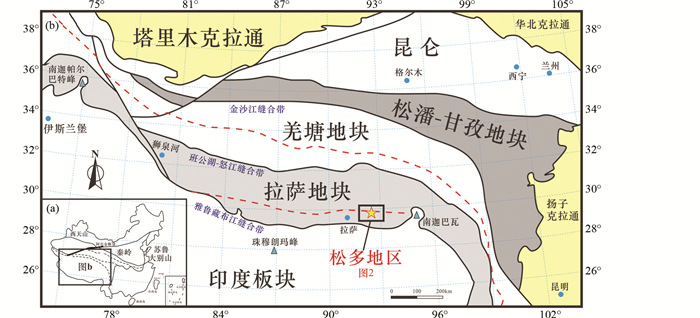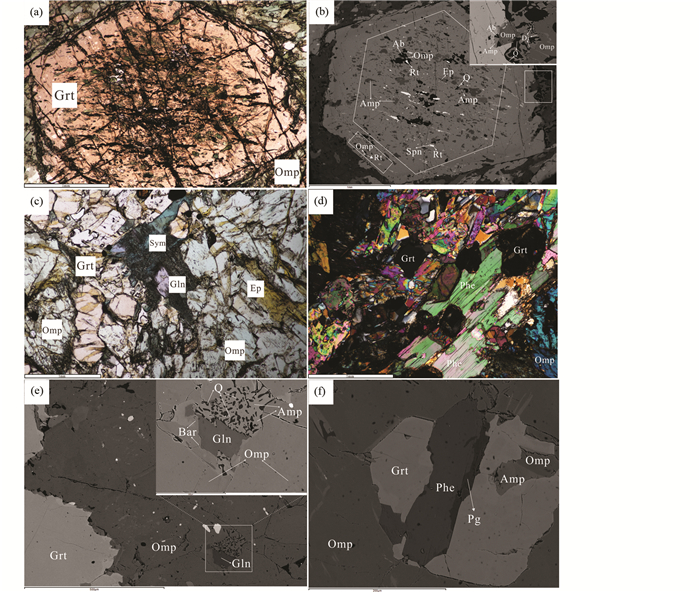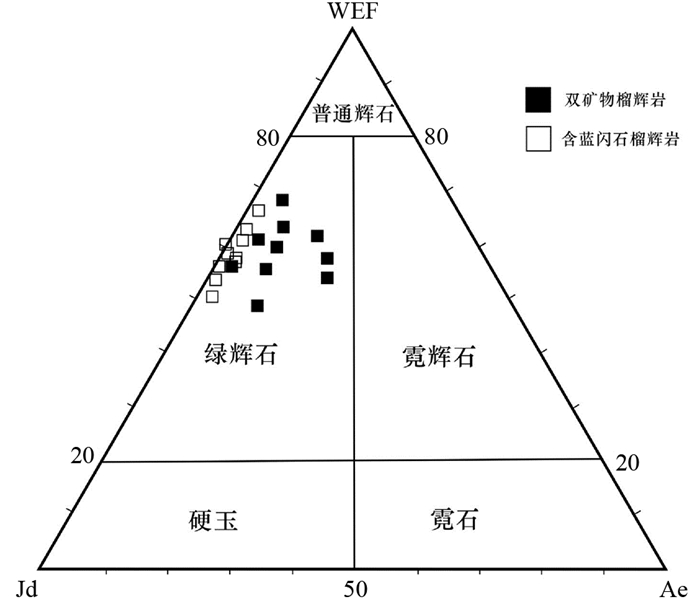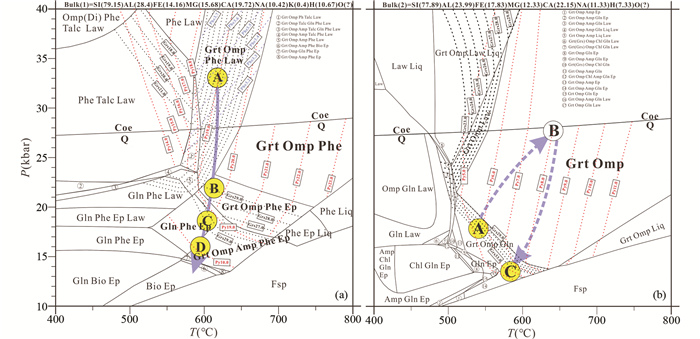2. 山东科技大学地球科学与工程学院, 青岛 266590;
3. 国家地质实验测试中心, 北京 100037
2. College of Geological Science & Engineering, Shandong University of Science and Technology, Qingdao 266590, China;
3. National Research Center for Geoanalysis, Beijing 100037, China
高压-超高压变质带是古板块汇聚边界及洋-陆、陆-陆俯冲碰撞的重要标志,记录了洋壳或陆壳俯冲-碰撞-折返一系列动力学过程的重要地质信息(Smith, 1988; Ernst and Liou, 1995; Maruyama et al., 1996; Ernst, 2001, 2006; Song et al., 2006, 2009; Cao et al., 2017c),一直是变质地质学关注的焦点。研究发现,高压-超高压变质多见于陆-陆俯冲碰撞过程中,由洋壳俯冲而形成的且明确经历了超高压变质作用的变质带则比较少见。前人统计了全球范围的高压-超高变质带,具有确切证据(含金刚石或柯石英)发生了洋壳深俯冲超高压变质作用的只有西阿尔卑斯的Zermatt-saas变质带以及我国西南天山变质带(Reinecker, 1991; Zhang et al., 2002a, b, 2003, 2005)。榴辉岩作为板块俯冲碰撞产生的典型岩石类型记录了俯冲过程及造山带演化的重要地质信息,是了解板块俯冲及造山过程的主要窗口。通过对榴辉岩的峰期温压条件及退变质矿物组合变化的研究结合岩石地球化学工作,对于区分造山带类型及了解造山带形成和演化有十分重要的意义。
拉萨地块松多榴辉岩带自2006年发现以来得到了学者的广泛关注(Yang et al., 2009; 曾令森等, 2009; Li et al., 2009; Cheng et al., 2012, 2015; Weller et al., 2016; Zhang et al., 2018a; Cao et al., 2017a, b),榴辉岩原岩具有典型的MORB特征(陈松永等, 2007; Cheng et al., 2012),其围岩是一套含有石榴石白云母片岩、二云母片岩、千枚岩和石英岩的沉积变质岩,与世界上典型的洋壳俯冲型榴辉岩的围岩岩石组合相似(Zhang et al., 2008),变质相平衡模拟显示围岩经历了与榴辉岩极为类似的变质演化过程(陈梅等, 2015; Zhang et al., 2018b)。除榴辉岩外,该区还伴生具有蛇绿岩特征的基性-超基性岩以及蓝片岩(Chen et al., 2009; Liu et al., 2009)。一系列证据显示,松多榴辉岩带应代表一条大洋型俯冲变质带。然而,针对松多榴辉岩变质演化P-T轨迹的研究工作相对薄弱,甚至对榴辉岩峰期变质条件和矿物共生组合还没有一个统一的认识。已开展的岩石学研究工作对榴辉岩的形成温压条件存在两种截然不同的观点:一种认为松多榴辉岩属于中温榴辉岩,通过不同版本的石榴石-单斜辉石(GC)温度计(Green and Hellman, 1982; Powell, 1985; Krogh, 1988; Ravna, 2000; Krogh Ravna and Terry, 2004)和石榴石-单斜辉石-多硅白云母(GCP)地质压力计估算(Waters and Martin, 1993; Krogh Ravna and Terry, 2001, 2004),其峰期变质温压条件:730℃、25.8~26.7kbar (Yang et al., 2009);760~800℃(张丁丁等, 2011)和753~790℃、34~38kbar (Cheng et al., 2012)。另一种则认为松多榴辉岩属于低温榴辉岩,通过相平衡模拟得到的峰期变质条件为:453~481℃、24~26kbar (Cheng et al., 2015);610℃、30kbar(杨现力等, 2014)和620℃、32kbar(黄杰等, 2015)。可以看到,利用传统地质温压计所得到的温度、压力条件相差悬殊,甚至对处于同一变质带相同露头的榴辉岩估算的温度范围都有高达230℃的偏差,压力的计算误差也在10kbar左右。Krogh Ravna and Paquin (2004)认为GC温度计误差主要来自于绿辉石中Fe3+的不可检测。魏春景等(2009, 2013)认为低温超高压榴辉岩由于石榴石边部贫钙,会使GCP压力计的计算结果偏低。故而,对松多榴辉岩峰期变质条件以及进一步的P-T变质演化轨迹仍需进一步深入的研究。
本文的研究对象为松多变质带以西新达多榴辉岩。通过岩相学、精细矿物学的研究,辅以传统地质温压计和变质相平衡模拟两种方法,讨论区内两类榴辉岩的温压条件和成因类型,揭示其变质演化轨迹,从而对松多榴辉岩变质带的地质演化进行进一步限定。文中所使用的矿物缩写如下:Grt-石榴石(Alm-铁铝榴石,Py-镁铝榴石,Grs-钙铝榴石,Sps-锰铝榴石),Omp-绿辉石,Di-透辉石,Jd-硬玉,Gln-蓝闪石,Bar-冻蓝闪石,Talc-滑石,Law-硬柱石,Czo-斜黝帘石,Phe-多硅白云母,Pg-钠云母,Bio-黑云母,Ep-绿帘石,Ab-钠长石,Chl-绿泥石,Q-石英,Coe-柯石英,Rt-金红石,Sph-榍石,Ap-磷灰石。
2 区域地质背景青藏高原是特提斯洋盆多期扩张与消减和其间微陆块多期次俯冲-碰撞的产物,具有长期、复杂的地质演化历史。一般认为,青藏高原自北向南由松潘-甘孜、羌塘、拉萨地体和喜马拉雅带组成,它们之间依次为金沙江(JS)、班公湖-怒江(BN)和印度-雅鲁藏布江(IYZ)缝合带(Yin and Harrison, 2000),这些缝合带分别代表古特提斯、中特提斯和新特提斯洋盆的残余(图 1)。

|
图 1 青藏高原地理位置(a)和青藏高原构造单元划分简图及研究区位置(b) Fig. 1 Geological map showing the location of the Qinghai-Tibet Plateau (a) and simplified map of tectonic subdivision in the Qinghai-Tibet Plateau and the location of the study area (b) |
拉萨地块位于班公湖-怒江缝合带和雅鲁藏布江缝合带之间,地理位置上西起狮泉河、冈仁波齐,向东经念青唐古拉山与伯舒拉岭相连,南北宽约300km,东西向延伸约2000km,面积达450000km2。该区除发育有冈底斯中、新生代岛弧及活动陆缘火山岩外,还出露有一定数量的变质岩。其中零星状分布的念青唐古拉岩群被认为是拉萨地块中最古老的变质基底,岩石类型有含石榴黑云斜长片麻岩、黑云二长片麻岩、斜长角闪岩、大理岩、石英岩及花岗片麻岩等。变质基底年龄最初通过羊八井北沟的眼球状黑云母片麻岩中的锆石U-Pb定年确定为1250Ma (西藏自治区地质矿产局, 1994),但之后在那木错西缘和那曲以北地区得到的念青唐古拉岩群表壳岩石和变质深成岩SHRIMP锆石U-Pb年龄748~787Ma (胡道功等, 2005)、多巴地区花岗片麻岩LA-ICP-MS锆石U-Pb年龄847±5.7Ma (李鹏等, 2016)显示拉萨地块存在新元古代变质基底。在拉萨地块中还出露一套岩石类型主要为绿帘角闪岩、含石榴石云母石英片岩、大理岩、石英岩等的变质碎屑岩,变质程度从低绿片岩相到角闪岩相。时代上有人认为是前奥陶纪,并从中划分出岔萨冈岩组、马布库岩组和雷龙库岩组(西藏自治区地质矿产局, 1994),但新版《1:150万青藏高原及其邻区地质图》将其时代划定为石炭纪-二叠纪(中国地质调查局成都地质矿产研究所,2004),正是在该地层单元中发现了指示板块缝合边界的榴辉岩。
松多榴辉岩带产出于拉萨市北东方向约200km的松多乡一带,位于拉萨地块的中东部,呈近东西向延伸,已知规模100km以上。自东向西,榴辉岩依次在吉朗村、白朗村、松多、新达多出露。本文研究区位于松多榴辉岩带西侧的新达多地区,榴辉岩呈透镜状产于石榴石云母片岩、绿帘角闪岩、石英岩等围岩中,产状与围岩不一致。研究对象采样点如图 2所示。

|
图 2 新达多地区区域地质简图及榴辉岩野外特征 (a)研究区区地质简图(据陈梅等, 2015修改)及样品位置分布;(b)新达多沟榴辉岩剖面示意图;(c、d)榴辉岩野外照片 Fig. 2 The sketch geological map of the Xindaduo area and the field relationship of the eclogites (a) simplified map of tectonic subdivision of the study area (revised after Chen et al., 2015) and sample location; (b) geological section of Xindaduo eclogite; (c, d) field photograph of fresh eclogite in the Xindaduo area |
新达多榴辉岩主要有两种类型:含蓝闪石榴辉岩和双矿物榴辉岩,对应样品编号分别为15SD40和15SD23。两类榴辉岩均呈透镜状产出,围岩为变质程度不同的绿帘角闪岩、白云母片岩、绿片岩、石英岩及黑云母片岩等(图 2b-d)。该区榴辉岩普遍遭受蚀变,透镜体中间部位保留较新鲜榴辉岩,边部大多已退变为石榴石角闪岩。值得关注的是,在榴辉岩出露区往往还伴随着超基性岩的产出,且超基性岩大多发生了蛇纹石化。榴辉岩和蛇纹石化的超基性岩之间的关系仍需要进一步详细的野外地质工作进行确定。
3.1.1 含蓝闪石榴辉岩含蓝闪石榴辉岩主要由石榴石(35%~40%)、绿辉石(30%~35%)、蓝闪石(5%~10%)、绿帘石(5%~10%)和多硅白云母(5%~10%)组成,此外还含有少量的石英、金红石、钛铁矿、钠钙质闪石(图 3c, d)。蓝闪石榴辉岩呈粒状变晶结构、块状构造,变斑晶矿物为绿辉石。石榴石颗粒普遍较小,不发育核-边结构。绿辉石多为粗粒变斑晶,呈自形-半自形,部分绿辉石看似为大斑晶,实则由众多细粒绿辉石聚集而成。蓝闪石多呈细粒自形-半自形晶,具有核-边结构。多硅白云母呈鳞片状,具定向性。绿帘石及闪石矿物较集中分布于变斑晶绿辉石及石榴石的边部。

|
图 3 新达多地区两类榴辉岩的矿物学显微照片 (a)双矿物榴辉岩变斑晶石榴石具有典型的环带结构;(b)变斑晶石榴石内部发育大量的包体, 其中核幔部包体成分复杂多样, 主要有绿辉石、角闪石、钠长石、绿帘石、金红石、钛铁矿、榍石, 相对干净的边部包体成分单一,为绿辉石、金红石;(c、d)含蓝闪石榴辉岩主要矿物组合:石榴石、绿辉石、蓝闪石、多硅白云母;(e)以绿辉石包体形式存在的蓝闪石, 其周围发育有角闪石+石英的后成合晶, (f)多硅白云母受后期退变质作用影响,边部发育有钠云母 Fig. 3 Optical and electron microphotographs of textures in both types of eclogite from the Xindaduo area (a) the garnet porphyroblast in bimineralic eclogite shows typical composition zonation; (b) diverse inclusions of omphacite amphibole albite epidote rutile ilmenite sphene in the core to mantle of the garnet porphyroblasts, but only omphacite and rutile inclusions in the rim of the garnet porphyroblasts; (c, d) the general mineral assemblage of the glaucophane-bearing eclogite: garnet omphacite glaucophane phengite; (e) the glaucophane inclusion of omphacite retrograded to amphibole+quartz symplectite; (f) the phengite in the matrix retrograded to paragonite |
双矿物榴辉岩主要由石榴石(30%~35%)、绿辉石(40%~45%)、钠钙质闪石(5%~10%)和石英(10%~15%)组成,含有少量的金红石、榍石、钛铁矿、帘石、钠长石、磷灰石(图 3a, b)。该类榴辉岩与蓝闪石榴辉岩的主要区别是不含蓝闪石和多硅白云母等特征变质矿物。双矿物榴辉岩呈粒状变晶结构、块状构造,变斑晶矿物为石榴石。石榴石呈自形-半自形粒状结构,粒径大于2mm。具有典型的核-边结构。石榴石普遍发育裂隙,含有较多包体,包体矿物主要有绿辉石、角闪石、钠长石、绿帘石、金红石、钛铁矿、榍石以及磷灰石(图 3b)。绿辉石呈半自形或不规则粒状充填于变斑晶石榴石之间。钠钙质闪石及石英不均匀分布于基质中。
3.2 矿物化学特征矿物化学成分分析在同济大学海洋地质国家重点实验室完成,仪器型号为JEOL JAX-8230。测试条件:加速电压20kV,选择5μm的电子束斑测定云母类矿物,3μm的电子束斑测定闪石、帘石类矿物,1μm的电子束斑测定石榴石和绿辉石。代表性矿物成分见表 1。
|
|
表 1 新达多地区两类榴辉岩中代表性矿物的电子探针成分(wt%) Table 1 Microprobe analyses of representative minerals of two types of eclogite from Xindaduo area, Lhasa terrane (wt%) |
含蓝闪石榴辉岩中的石榴石呈自形-半自形粒状结构,粒径较小,平均在0.5mm左右,以基质的形式充填于岩石之中。石榴石主要有铁铝榴石(Alm)、镁铝榴石(Py)、钙铝榴石(Grs)和锰铝榴石(Sps)组成,其中以铁铝榴石组分为主,含量约为50%,最高不超过55%。各个端元组分没有明显的变化,说明石榴石不发育环带结构。
相比较而言,双矿物榴辉岩中的石榴石颗粒较大,平均粒径在2mm左右。石榴石主要由铁铝榴石(Alm)、镁铝榴石(Py)、钙铝榴石(Grs)和锰铝榴石(Sps)组成,其中以铁铝榴石组分为主,含量可达65%以上。各个端元组分都表现出显著的成分环带特征(表 1和图 4),从核、幔部到边部钙铝榴石和镁铝榴石组分先升高后又逐渐降低,铁铝榴石组分含量则先降低后升高,且在石榴石的边部发育有成分为角闪石和石英的冠状体。这一系列特征表明变斑晶石榴石前期有一个进变质生长过程,后期由于温压条件的变化而发生了退变质作用。

|
图 4 新达多双矿物榴辉岩中变斑晶石榴石成分剖面及电子探针面扫描图谱 Fig. 4 EPMA mapping showing the composition zonation of garnet porphyroblasts and zoning profile of garnets in bimineralic eclogite from Xindaduo area |
含蓝闪石榴辉岩中绿辉石呈半自形柱状或粒状变斑晶,内部含有蓝闪石、金红石、石英、绿帘石等包体。部分变斑晶绿辉石具有显著的成分环带特征,从绿辉石的核部到边部,硬玉的含量有所变化(图 5)。

|
图 5 新达多榴辉岩单斜辉石的普通辉石-霓石-硬玉三成分图解 Fig. 5 Ternary plot of diopside-jadite-aegirine showing composition of omphacite in Xindaduo eclogite Lhasa Block |
双矿物榴辉岩中绿辉石主要有三种存在形式:一种是以包体形式存在于变斑晶石榴石中,一种以基质形式存在,还有一种呈后成合晶形式出现。其中包体绿辉石中硬玉含量(Jd)在0.25~0.44之间,后成合晶绿辉石中硬玉含量为0.30~0.35,略低于基质(图 5),表明绿辉石可能经历了多阶段的生长过程。
3.2.3 角闪石含蓝闪石榴辉岩中角闪石有三种存在形式:基质、冠状体和后成合晶。基质角闪石多为淡蓝色蓝闪石,显示无定向分布,充填在石榴石和绿辉石颗粒之间,边部发育蠕虫状后成合晶。有些蓝闪石核部保留有绿辉石残留(图 3e),说明蓝闪石可能是后期退变质过程中生成的。石榴石冠状体闪石矿物成分显示为韭闪石和绿铁闪石(图 6a) (Si=6.0~6.5, (Na)M4=0.4~0.7);蓝闪石后成合晶成分较为一致,均为冻蓝闪石(Si=6.5~7.5, (Na)M4=0.7~1.1)和石英组合。

|
图 6 新达多地区榴辉岩中角闪石成分及分类图(a)和多硅白云母的(Mg+Fe)-Si的成分图(b) Fig. 6 The composition and classification diagram for amphibole (a) and (Mg+Fe) vs. Si diagram for phengite (b) in Xindaduo eclogite |
双矿物榴辉岩中角闪石同样有三种赋存形式:基质、包体以及冠状体。其中以基质形式赋存矿物之间的角闪石成分为红闪石;而变斑晶石榴石包体中的角闪石成分除去红闪石外,还多了绿铁闪石;以石榴石冠状体形式存在的角闪石成分为镁铁闪石。由此可见,两类榴辉岩中以不同形式呈现出的角闪石在其矿物化学成分上面存在着细微的差别(图 6a)。
3.2.4 多硅白云母多硅白云母只在含蓝闪石榴辉岩中有发现,双矿物榴辉岩中并未发现。多硅白云母主要以针状和片状存在于含蓝闪石榴辉岩基质中,未发现以包体形式存在的多硅白云母。基质中的多硅白云母Si含量(p.f.u.; 其中p.f.u.为单个分子中的离子数, 上同)在3.36~3.45(图 6b)之间,部分多硅白云母边部退变为钠云母(图 3f),原因可能是后期流体沿矿物裂隙对其进行了改造作用。在退变质作用过程中,多硅白云母常发生不同程度的成分重置和退变质反应的改造,所以选取具有最高硅含量的多硅白云母估算峰期压力较为合适。
4 温压计算与相平衡为了更好地对新达多地区榴辉岩的峰期变质条件进行限定,本文利用传统温压计和变质相平衡模拟两种不同方法来进行计算。传统温压计计算以矿物间成分局部平衡为前提,相平衡模拟则以岩石全岩成分达到平衡为基础。具体计算结果如下。
4.1 榴辉岩峰期温压条件计算榴辉岩存在多种不同版本的温压计,如石榴石-单斜辉石温度计(Ellis and Grseen, 1979; Powell, 1985; Krogh Ravna, 1988, 2000)、石榴石-多硅白云母压力计(Green and Hellman, 1982)、石榴石-单斜辉石-多硅白云母压力计(Waters and Martin, 1993, 1996)、石榴石-绿辉石-蓝晶石-柯石英温压计(Nakamura and Banno, 1997)和石榴石-单斜辉石-多硅白云母-蓝晶石-柯石英/石英温压计(Krogh Ravna and Terry, 2004)等,多种因素都会影响温压计的准确计算。例如在应用石榴石-单斜辉石地质温度计进行榴辉岩峰期变质P-T条件估算时,需要确定矿物中Fe2+的含量,石榴石和绿辉石中Fe2+/Fe3+比值对于温度计的影响十分巨大。所以选择合理有效的温压计是计算榴辉岩变质条件的前提。本文拟采用Krogh Ravna and Terry (2004)提出的石榴石-绿辉石-多硅白云母温压计进行榴辉岩峰期变质条件的计算。在选取矿物对计算时,按照Carswell et al. (2000)制定的原则,在存在环带结构的石榴石变斑晶中,选取(αGrs)*2(αPy)值最大处成分,绿辉石选取硬玉组分最大处成分,多硅白云母选取化学式中硅含量最大的成分,另外利用电价平衡法对矿物中的Fe2+进行了校正。
通过以上方法计算得到含蓝闪石榴辉岩峰期变质温压条件为682~701℃、31±0.5kbar;双矿物榴辉岩峰期变质温度为650~663℃,峰期变质压力则因缺少指示性的特征变质矿物,故暂时认定其压力不超过柯石英转变压力27kbar。温压数据表明,两类榴辉岩可能并未经历相同的俯冲变质过程,但同属中低温榴辉岩(Carson et al., 1999; Zhang et al., 2008)。
4.2 变质相平衡模拟计算利用Theriak-Domino软件(de Capitani, 1994)对新达多地区两类榴辉岩进行了P-T视剖面模拟。含蓝闪石榴辉岩采用Na2O-CaO-K2O-FeO-Al2O3-SiO2-H2O-O(Fe2O3)(NCKFMASHO)体系模拟其变质作用过程,而双矿物榴辉岩因全岩钾含量低且无含钾矿物故采用Na2O-CaO-FeO-Al2O3-SiO2-H2O-O(Fe2O3)(NCFMASHO)体系进行计算。流体相设为纯水,并假设水和多硅白云母过饱和,考虑到P2O5主要形成磷灰石,且在主要硅酸盐矿物中含量均很少,因此不考虑P2O5组分。
榴辉岩样品15SD40和15SD23的全岩地球化学成分在国家地质实验测试中心通过X射线荧光衍射(XRF)方法分析所得(表 2),其中Fe2O3含量采用湿化学法测定,用于相平衡模拟计算时将其换算为模拟体系中的mole百分比进行计算。使用Holland et al. (1998)热力学数据库,所涉及的固溶体活度模型为石榴石(Holland et al., 1998)、单斜辉石(Green et al., 2007)、角闪石(Diener et al., 2007)、绿帘石(Holland et al., 1998)、白云母(Coggon and Holland, 2002)、斜长石(Newton et al., 1980)、黑云母(Tajčmanová et al., 2009)、滑石(Holland et al., 1998),黝帘石、石英/柯石英、硬柱石和水设为纯端元相。
|
|
表 2 新达多含蓝闪石榴辉岩(15SD40)和双矿物榴辉岩(15SD23)的全岩化学成分以及两者的有效全岩化学成分 Table 2 Whole-rock and effective geochemical compositions of Xindaduo glaucophane-bearing eclogite(15SD40) and double mineral eclogite(15SD23) |
在含蓝闪石榴辉岩视剖面图(图 7a)中计算并标示出了石榴石的镁铝榴石(Py)等值线、钙铝榴石(Grs)等值线和多硅白云母硅(Si)等值线。在含硬柱石的榴辉岩组合(Grt+Omp+Law)中,多硅白云母具有中等-平缓的正斜率,随压力的增加而增加;石榴石中钙铝榴石基本不随温度和压力变化而变化;而镁铝榴石具有中等的正斜率,随温度的升高而升高。含蓝闪石矿物组合(Grt+Omp+Gln+Ep)稳定域中,镁铝榴石具有中等的负斜率,随温度的升高而降低;而在角闪石组合(Grt+Omp+Amp)中钙铝榴石具有中等的正斜率,随温度的升高而升高。利用多硅白云母最大Si含量和石榴石中镁铝榴石XPy含量投图,限定得到峰期矿物共生组合为(Grt+Omp+Law),变质温度为615℃左右,压力可达33kbar,超过了石英和柯石英转变线,属于低温超高压变质作用温压条件范围。

|
图 7 含蓝闪石榴辉岩(15SD40)在NCKFMASH体系下的P-T视剖面图(a)和双矿物榴辉岩(15SD23)在NCFMASH体系下的P-T视剖面图(b) 使用全岩成分见表 2,均换算成模式体系中的mole百分含量.此外(a)图中包含主要稳定域矿物组合以及石榴石中镁铝榴石(Py)、钙铝榴石(Grs)含量等值线以及多硅白云母(Phe)Si-含量等值线; (b)图中同样包含主要稳定域矿物组合以及石榴石中镁铝榴石(Py)、钙铝榴石(Grs)含量等值线 Fig. 7 P-T pseudosection in the system NCKFMASH for sample 15SD40 (a) and P-T pseudosection in the system NCFMASH for sample 15SD23 (b) The bulk composition in this pseudosection see Table 2, and recalculated on the basis of normalized mol%. Besides, (a) the pseudosection are contoured with isopleths of pyrope and grossular in garnet for the relevant mineral assemblages, also with the isopleths of Si content in phengite, (b) the pseudosection are contoured with isopleths of pyrope and grossular in garnet for the relevant mineral assemblages |
在双矿物榴辉岩视剖面图(图 7b)中同样计算并标出了石榴石的镁铝榴石(Py)等值线、钙铝榴石(Grs)等值线。在双矿物榴辉岩矿物组合(Grt+Omp+Ep+Amp)中,镁铝榴石斜率较陡,随温度升高而升高;钙铝榴石具有较陡的负斜率,随温度升高而降低。在有长石出现的稳定域内镁铝榴石和钙铝榴石均表现为平缓的负斜率,此时可利用钙铝榴石含量指示其压力变化。在峰期矿物组合(Grt+Omp)稳定域中,镁铝榴石具有较陡的正斜率,随温度的升高而升高,能够很好的模拟出峰期变质温度为630±10℃。在此稳定域中,由于矿物组合单一,石榴石和绿辉石主要发生Fe-Mg离子的交换,故不见钙铝榴石等值线与镁铝榴石等值线相交,无法给出确定的峰期压力数值。但据此矿物成分含量变化,结合对其岩相学的观察基础,认为其压力应该不超过27kbar。
5 讨论 5.1 峰期变质条件和矿物组合拉萨地块松多榴辉岩自2006年发现以来(杨经绥等, 2006),大量关于榴辉岩岩石学的工作随继开展(李天福等, 2007; Yang et al., 2009; 曾令森等, 2009; Cheng et al., 2012, 2015; Zhang et al., 2018a, b),但直到目前为止关于其峰期变质条件和矿物组合的争论依旧存在。据已发表的峰期温压条件来看,争论焦点在于榴辉岩是否经历了深俯冲发生超高压变质作用?有的学者根据松多榴辉岩变质峰期条件730℃、25.8~26.7kbar (Yang et al., 2009)和白朗榴辉岩变质峰期条件453~481℃、24~26kbar (Cheng et al., 2015),认为榴辉岩属于俯冲高压变质的产物;另外部分学者则根据松多榴辉岩变质峰期条件为760~800℃、33~39kbar (张丁丁等, 2011);610℃、30kbar (杨现力等, 2014)及620℃、32kbar (黄杰等, 2015)和吉朗榴辉岩变质峰期条件753~790℃、34~38kbar (Cheng et al., 2012)等认为榴辉岩是深俯冲超高压变质的产物。
本文利用传统矿物对地质温压计对新达多地区两类榴辉岩峰期变质条件进行限定得到:(1)含蓝闪石榴辉岩变质峰期矿物组合为石榴石、绿辉石、多硅白云母;石榴石-单斜辉石(GC)温度计(Krogh Ravna, 2000)和石榴石-单斜辉石-多硅白云母(GCP)压力计(Krogh Ravna and Terry, 2004)计算结果为682~701℃、30±1kbar;(2)双矿物榴辉岩变质峰期矿物组合为石榴石、绿辉石;GC温度计(Krogh Ravna, 2000)计算结果为650~663℃,压力因未发现柯石英或者柯石英假象而初步认为其不超过27kbar。
利用相平衡对新达多榴辉岩峰期变质条件进行模拟得到:(1)含蓝闪石榴辉岩根据石榴石中镁铝榴石(Py)含量最大值与多硅白云母中Si含量最大值的交点得到其峰期变质条件为:615±5℃、33±0.5kbar;该温压范围内峰期矿物组合是石榴石、绿辉石、硬柱石、多硅白云母。相平衡模拟计算表明该区榴辉岩峰期位于硬柱石稳定域,但在样品中并未发现任意形式存在的硬柱石,甚至是硬柱石假象。这一现象看似矛盾,实则在洋壳俯冲形成的榴辉岩中普遍存在(Clarke et al., 2006; Tsujimori et al., 2006; Wei and Clark, 2011; 魏春景和崔莹, 2011)。其中魏春景和崔莹(2011)认为硬柱石在榴辉岩中难以保存的原因主要在于岩石在后期的折返过程中受到退变质作用影响。松多地区榴辉岩中石榴石普遍发育裂理,容易遭受后期的改造,故除少数地区榴辉岩中残存硬柱石假象外(Cheng et al., 2015),大部分地区榴辉岩都未发现硬柱石的痕迹。因此这与相平衡模拟结果显示的峰期矿物组合在硬柱石稳定域并不矛盾。(2)双矿物榴辉岩根据石榴石中镁铝榴石(Py)和钙铝榴石(Grs)含量的变化得到其峰期变质条件为630±10℃,压力不超过27kbar;峰期矿物组合为石榴石、绿辉石、石英。
利用传统温压计和相平衡两种手段得到的峰期变质条件有一定的出入,温度方面Krogh Ravna and Paquin (2004)认为GC温度计的误差主要来自绿辉石中Fe3+的不确定性;而压力方面之所以压力计较相平衡计算结果低的原因在于:在含有硬柱石的高压-超高压榴辉岩中,石榴石中的钙含量受到硬柱石的控制,随着压力升高或温度降低,硬柱石含量增加,使石榴石中钙降低。此时石榴石、绿辉石、多硅白云母之间的转换反应对石榴石成分的影响会很微弱,因此石榴石会因相对贫钙而导致GCP压力计计算结果偏低(魏春景等, 2009)。从温压计算结果可以看出:含蓝闪石榴辉岩和双矿物榴辉岩均属于低温榴辉岩,类似洋壳俯冲的产物;但二者压力又分属于超高压和高压变质的界限,将此现象解释为两类榴辉岩是洋壳不同块体在俯冲过程中达到不同深度记录变质作用的结果。这也很可能是两类榴辉岩在全岩成分相差不大的情况下矿物组合存在差异的主要原因。
5.2 P-T演化过程结合新达多地区两类榴辉岩的野外地质产状、岩相学和相平衡模拟工作,将两类榴辉岩的变质演化阶段分别进行了如下划分:含蓝闪石榴辉岩因缺少进变质阶段矿物的保存,记录的变质演化过程为峰期变质阶段-退变质初期近等温减压变质阶段-中晚期退变质阶段;双矿物榴辉岩则记录了早期进变质阶段-峰期变质阶段-晚期退变质阶段。
含蓝闪石榴辉岩变质演化过程:(1)峰期变质阶段,在NCKFMASHO模式体系下依据全岩成分计算得到Grt-Omp-Phe-Law (Rt+Coe+H2O)的峰期矿物组合。在此矿物组合域中,镁铝榴石含量主要受温度控制(图 7a),随温度升高而升高,可以很好的指示温度的变化,故利用石榴石中最大的XPy值在该组合域中确定出岩石形成的峰期温度;然而钙铝榴石含量则不单单受到压力的控制,而是随着全岩成分的改变发生显著的变化,因此用其含量来限定峰期压力会因岩石中局部成分的不均而产生不能忽视的误差。相反多硅白云母中的Si含量在该组合域中则几乎不受全岩成分的影响,可以被用来指示岩石形成的峰期压力。石榴石中镁铝榴石(Py)端元最大含量和多硅白云母最大Si含量指示得出岩石峰期的变质条件为:615±5℃、33±0.5kbar。(2)退变质初期近等温减压变质阶段,相平衡模拟表明含蓝闪石榴辉岩在达到峰期后经历了以近等温减压为特征的快速折返过程。这一阶段发生在硬柱石稳定域内,以硬柱石的脱水反应为主要特征(Law→Grt+H2O; Law+Omp→Grt+Gln+Ep+H2O),温压条件变为605~610℃、20~24kbar。岩相学方面,在基质中观察到的蓝闪石和绿帘石(图 2c)可与这一阶段相对应。(3)中晚期退变质阶段,该阶段变质作用以硬柱石消失后继续减压退变至出现冻蓝闪石以及晚期的绿帘角闪岩相矿物组合为特征(图 2c, e)。早期硬柱石脱水反应释放出的大量水所形成的局部富流体域中生成大量的绿帘石和蓝闪石,直至出现流体缺失状态。之后继续减压至大约16kbar时,冻蓝闪石在蓝闪石边部生成,残余的蓝闪石说明了体系中没有足够的外来水使岩石稳定在冻蓝闪石稳定域内。当压力再降至12kbar左右时,斜长石出现,这与岩石中绿辉石边部生成有角闪石+钠长石及蓝闪石边部广泛发育角闪石+石英后成合晶相一致。
双矿物榴辉岩变质演化过程:(1)早期进变质阶段,以变斑晶石榴石中镁铝榴石和钙铝榴石在核部的成分含量模拟得出,其矿物组合为石榴石、以包体形式存在的单斜辉石、绿帘石、角闪石(图 2b)。(2)峰期变质阶段,以石榴石边部镁铝榴石(Py)和钙铝榴石(Grs)含量模拟得到其峰期变质条件为630±10℃,压力不超过27kbar。压力因矿物组合过于单一,矿物间成分交换缺失而无法给定具体数值。矿物组合为石榴石、绿辉石。(3)晚期退变质阶段,以石榴石边部发育冠状体及绿辉石生成后成合晶为主要特征(图 2b)。其中石榴石边部冠状体成分为钠长石+角闪石;绿辉石后成合晶矿物成分为透辉石+石英。另外金红石边部退变为榍石也应为这一阶段的产物。
5.3 新达多地区榴辉岩的地质意义传统温压计和相平衡模拟两种手段的研究结果表明,新达多地区以含蓝闪石低温矿物为特征的榴辉岩和双矿物榴辉岩均归属于洋壳俯冲型的低温榴辉岩。地球化学证据显示,松多榴辉岩原岩具有MORB或OIB性质(陈松永等, 2007; Cheng et al., 2012),再结合在松多变质带发现的超镁铁质岩石、大洋和洋岛玄武岩等蛇绿岩带岩石组合(陈松永, 2010),以及蓝片岩的出露(Liu et al., 2009),认为松多榴辉岩带可能代表了青藏高原拉萨地块内一条新的大洋型俯冲变质带。石榴石Lu-Hf得到的约266Ma (Cheng et al., 2012)的榴辉岩相变质年龄说明在拉萨地块内部存在过一个二叠纪的古特提斯洋盆。
含蓝闪石榴辉岩峰期压力为30~33kbar,而双矿物榴辉岩峰期压力则不超过27kbar,两者分属于超高压和高压榴辉岩。不同学者之前关于松多榴辉岩变质峰期压力的认识也大不相同,同样也可归纳为超高压和高压两种观点。以峰期压力来看,同一变质带中的榴辉岩属于两种截然不同的类型,此种现象不单单出现在松多榴辉岩变质带内,世界范围内其他的榴辉岩变质带也有所表征。同一地区榴辉岩有着变化显著的峰期温压条件,甚至在同一露头处相邻的榴辉岩块体都可能具有迥异的峰期压力值(Krebs et al., 2011; 郑永飞等, 2013; Li et al., 2015),这一特征可能暗示了洋壳高压-超高压变质岩石的俯冲隧道折返过程(Bebout, 2007; Zheng, 2012; Zheng et al., 2012; 李继磊等, 2017)。新达多两类榴辉岩代表着该区榴辉岩并非全部经历了超高压变质作用,高压、超高压榴辉岩的发现可能是变基性岩块在不同俯冲深度的产物。
6 结论(1) 青藏高原拉萨地块新达多地区识别出两类榴辉岩:一类是以发育低温矿物为特征的含蓝闪石榴辉岩。传统温压计计算得到的峰期变质条件为682~701℃、30±1kbar;利用NCKFMASHO体系中的P-T视剖面图,结合石榴石边部最大XPy值和多硅白云母最大Si含量值确定的峰期变质条件为615±5℃、33±0.5kbar,对应的峰期矿物组合为Grt-Omp-Phe-Law (Rt+Coe+H2O)。另一类则是以发育典型环带结构的变斑晶石榴石为特征的双矿物榴辉岩,传统温压计得到其变质峰期温度为650~663℃;利用NCFMASHO体系中的P-T视剖面图,结合石榴石边部XPy值和XGrs值模拟得到其峰期变质条件为630±10℃,压力不超过27kbar,对应峰期矿物组合为Grt-Omp (Rt+Q+H2O)。
(2) 从峰期变质温度来看,两类榴辉岩均属于低温榴辉岩类型,具有典型的洋壳俯冲变质榴辉岩的特征;而按峰期变质压力来划分,含蓝闪石榴辉岩属于超高压榴辉岩,双矿物榴辉岩属于高压榴辉岩。同一地区相邻露头榴辉岩压力悬殊,原因可能在于该区榴辉岩经历了洋壳高压-超高压变质岩石的俯冲隧道折返过程,高压、超高压榴辉岩的发现可能是变基性岩块在不同俯冲深度折返的产物。
致谢 感谢中国地质大学(武汉)夏彬及西北大学苟龙龙副教授对本文提出的宝贵意见。西藏司机乔多吉、江错等在野外工作中提供了帮助,同济大学张灵敏工程师在电子探针成分测试方面提供了帮助,在此表示衷心感谢。
Bebout GE. 2007. Metamorphic chemical geodynamics of subduction zones. Earth and Planetary Science Letters, 260(3-4): 373-393. DOI:10.1016/j.epsl.2007.05.050 |
Bureau of Geology and Mineral Resources of Xizang Autonomous Region. 1994. Region Geological Survey Report of the People's Republic of China, 1:200000 Chin Tang (Voca) Picture. Beijing: Geological Publishing House.
|
Cao DD, Cheng H, Zhang LM and Wang K. 2017a. Post-peak metamorphic evolution of the Sumdo eclogite from the Lhasa terrane of southeast Tibet. Journal of Asian Earth Sciences, 143: 156-170. DOI:10.1016/j.jseaes.2017.04.020 |
Cao DD, Cheng H and Zhang L. 2017b. Pseudosection modelling and garnet Lu-Hf geochronology of HP amphibole schists constrain the closure of an ocean basin between the northern and southern Lhasa blocks, central Tibet. Journal of Metamorphic Geology, 35(7): 777-803. DOI:10.1111/jmg.2017.35.issue-7 |
Cao YT, Liu L, Chen DL, Wang C, Yang WQ, Kang L and Zhu XH. 2017c. Partial melting during exhumation of Paleozoic retrograde eclogite in North Qaidam, western China. Journal of Asian Earth Sciences, 148: 223-240. DOI:10.1016/j.jseaes.2017.09.009 |
Carson CJ, Powell R and Clark GL. 1999. Calculated mineral equilibria for eclogites in Cao-Na2O-FeO-MgO-Al2O3-SiO2-H2O:Application to the Pouébo Terrane, Pam Peninsula, New Caledonia. Journal of Metamorphic Geology, 17(1): 9-24. DOI:10.1046/j.1525-1314.1999.00177.x |
Carswell DA, Wilson RJ and Zhai M. 2000. Metamorphic evolution, mineral chemistry and thermobarometry of schists and orthogneisses hosting ultra-high pressure eclogites in the Dabieshan of central China. Lithos, 52(1-4): 121-155. DOI:10.1016/S0024-4937(99)00088-2 |
Chen M, Tian ZL, Zhang C, Yang JS and Huang J. 2015. Phase equilibrium modeling for metamorphic evolution of garnet-bearing mica-quartz schist in Sumdo UHP metamorphic belt, Lhasa Block. Geology in China, 42(5): 1572-1587. |
Chen SY, Yang JS, Luo LQ, Li ZL, Xu XZ, Li TF, Ren YF and Li HQ. 2007. MORB-type eclogites in the Lhasa block, Tibet, China:Petrochemical evidence. Geological Bulletin of China, 26(10): 1327-1339. |
Chen SY, Yang JS, Li Y and Xu XZ. 2009. Ultramafic blocks in Sumdo region, Lhasa block, eastern Tibet Plateau:An ophiolite unit. Journal of Earth Science, 20(3): 332-347. |
Chen SY. 2010. The development of Sumdo suture in the Lhasa Block, Tibet. Ph. D. Dissertation. Beijing:Chinese Academy of Geological Science, 1-199 (in Chinese with English summary)
|
Cheng H, Zhang C, Vervoort JD, Lu HH, Wang C and Cao DD. 2012. Zircon U-Pb and garnet Lu-Hf geochronology of eclogites from the Lhasa Block, Tibet. Lithos, 155: 341-359. DOI:10.1016/j.lithos.2012.09.011 |
Cheng H, Liu YM, Vervoort JD and Lu HH. 2015. Combined U-Pb, Lu-Hf, Sm-Nd and Ar-Ar multichronometric dating on the Bailang eclogite constrains the closure timing of the Paleo-Tethys Ocean in the Lhasa terrane, Tibet. Gondwana Research, 28(4): 1482-1499. DOI:10.1016/j.gr.2014.09.017 |
Chengdu Institute of Geology and Mineral Resources and China Geological Survey. 2004. Geological Map of Tibetan Plateau (1:1500000). Chengdu: Chengdu Cartographic Publishing House.
|
Clarke GL, Powell R and Fitzherbert JA. 2006. The lawsonite paradox:A comparison of field evidence and mineral equilibria modelling. Journal of Metamorphic Geology, 24(8): 715-725. DOI:10.1111/jmg.2006.24.issue-8 |
Coggon R and Holland TJB. 2002. Mixing properties of phengitic micas and revised garnet-phengite thermobarometers. Journal of Metamorphic Geology, 20(7): 683-696. DOI:10.1046/j.1525-1314.2002.00395.x |
de Capitani C. 1994. Gleichgewichts-Phasendiagramme:Theorie und Software. Berichte der Deutschen Mineralogischen Gesellschaft, Beiheft zum. European Journal of Mineralogy, 6: 48. |
Diener JFA, Powell R, White RW and Holland TJB. 2007. A new thermodynamic model for clino-and orthoamphiboles in the system Na2O-CaO-FeO-MgO-Al2O3-SiO2-H2O-O. Journal of Metamorphic Geology, 25(6): 631-656. DOI:10.1111/jmg.2007.25.issue-6 |
Ellis DJ and Green DH. 1979. An experimental study of the effect of Ca upon garnet-clinopyroxene Fe-Mg exchange equilibria. Contributions to Mineralogy and Petrology, 71(1): 13-22. DOI:10.1007/BF00371878 |
Ernst WG and Liou JG. 1995. Contrasting plate-tectonic styles of the Qinling-Dabie-Sulu and Franciscan metamorphic belts. Geology, 23(4): 353-356. DOI:10.1130/0091-7613(1995)023<0353:CPTSOT>2.3.CO;2 |
Ernst WG. 2001. Subduction, ultrahigh-pressure metamorphism, and regurgitation of buoyant crustal slices:Implications for arcs and continental growth. Physics of the Earth and Planetary Interiors, 127(1-4): 253-275. DOI:10.1016/S0031-9201(01)00231-X |
Ernst WG. 2006. Preservation/exhumation of ultrahigh-pressure subduction complexes. Lithos, 92(3-4): 321-335. DOI:10.1016/j.lithos.2006.03.049 |
Green E, Holland T and Powell R. 2007. An order-disorder model for omphacitic pyroxenes in the system jadeite-diopside-hedenbergite-acmite, with applications to eclogitic rocks. American Mineralogist, 92(7): 1181-1189. DOI:10.2138/am.2007.2401 |
Green TH and Hellman PL. 1982. Fe-Mg partitioning between coexisting garnet and phengite at high pressure, and comments on a garnet-phengite geothermometer. Lithos, 15(4): 253-266. DOI:10.1016/0024-4937(82)90017-2 |
Holland T, Baker J and Powell R. 1998. Mixing properties and activity-composition relationships of chlorites in the system MgO-FeO-Al2O3-SiO2-H2O. European Journal of Mineralogy, 10(3): 395-406. DOI:10.1127/ejm/10/3/0395 |
Hu DG, Wu ZH, Jiang W, Shi YR, Ye PS and Liu QS. 2005. SHRIMP zircon U-Pb age and Nd isotopic study on the Nyinqentanglha Group in Tibet. Science in China (Series D), 48(9): 1377-1386. DOI:10.1360/04yd0183 |
Huang J, Tian ZL, Zhang C, Yang JS and Chen M. 2015. Metamorphic evolution of Sumdo eclogite in Lhasa Block of the Tibetan Plateau:Phase equilibrium in NCKMnFMASHTO system. Geology in China, 42(5): 1559-1571. |
Krebs M, Schertl HP, Maresch WV and Draper G. 2011. Mass flow in serpentinite-hosted subduction channels:P-T-t path patterns of metamorphic blocks in the Rio San Juan mélange (Dominican Republic). Journal of Asian Earth Sciences, 42(4): 569-595. DOI:10.1016/j.jseaes.2011.01.011 |
Krogh Ravna EJ. 1988. The garnet-clinopyroxene Fe-Mg geothermometer:A reinterpretation of existing experimental data. Contributions to Mineralogy and Petrology, 99(1): 44-48. DOI:10.1007/BF00399364 |
Krogh Ravna K. 2000. The garnet-clinopyroxene Fe2+-Mg geothermometer:An updated calibration. Journal of Metamorphic Geology, 18(2): 211-219. DOI:10.1046/j.1525-1314.2000.00247.x |
Krogh Ravna EJ and Terry MP. 2001. Geothermobarometry of phengite-kyanite-quartz/coesite eclogites. In:11th Annual V. M. Goldschmidt Conference. Hot Springs, Virginia http://www.researchgate.net/publication/234183964_Geothermobarometry_of_Phengite-Kyanite-QuartzCoesite_Eclogites
|
Krogh Ravna EJ and Paquin J. 2004. Thermobarometric methodologite application to eclogites and garnet ultrabasites. EMU Notes in Mineralogy, 5(8): 229-259. |
Krogh Ravna EJ and Terry MP. 2004. Geothermobarometry of UHP and HP eclogites and schists-an evaluation of equilibria among garnet-clinopyroxene-kyanite-phengite-coesite/quartz. Journal of Metamorphic Geology, 22(6): 579-592. DOI:10.1111/jmg.2004.22.issue-6 |
Li JL, Klemd R, Gao J, Jiang T and Song YH. 2015. A common high-pressure metamorphic evolution of interlayered eclogites and metasediments from the "ultrahigh-pressure unit" of the Tianshan metamorphic belt in China. Lithos, 226: 169-182. DOI:10.1016/j.lithos.2014.12.006 |
Li JL, Gao J and Wang XS. 2016. A subduction channel model for exhumation of oceanic-type high-pressure to ultrahigh-pressure eclogite-facies metamorphic rocks in SW Tianshan, China. Science China (Earth Sciences), 59(12): 2339-2354. DOI:10.1007/s11430-016-5103-7 |
Li P, Zhang C, Liu XY, Yang JS and Fu YW. 2015. Metamorphic evolution processes and their geological implications of Gneisses from Duoba area of Tibet. Journal of Earth Sciences and Environment, 38(5): 601-611. |
Li TF, Yang JS, Li ZL, Xu XZ, Ren YF, Wang RC and Zhang WL. 2007. Petrography and metamorphic evolution of the Sumdo eclogite, Qinghai-Tibetan Plateau. Geological Bulletin of China, 16(10): 1310-1326. |
Li ZL, Yang JS, Xu ZQ, Li TF, Xu XZ, Ren YF and Robinson PT. 2009. Geochemistry and Sm-Nd and Rb-Sr isotopic composition of eclogite in the Lhasa terrane, Tibet, and its geological significance. Lithos, 109(3-4): 240-247. DOI:10.1016/j.lithos.2009.01.004 |
Liu Y, Liu HF, Theye T and Massonne HJ. 2009. Evidence for oceanic subduction at the NE Gondwana margin during Permo-Triassic times. Terra Nova, 21(3): 195-202. DOI:10.1111/ter.2009.21.issue-3 |
Maruyama S, Liou JG and Terabayashi M. 1996. Blueschists and eclogites of the world and their exhumation. International Geology Review, 38(6): 485-594. DOI:10.1080/00206819709465347 |
Nakamura D and Banno S. 1997. Thermodynamic modelling of sodic pyroxene solid-solution and its application in a garnet-omphacite-kyanite-coesite geothermobarometer for UHP metamorphic rocks. Contributions to Mineralogy and Petrology, 130(1): 93-102. DOI:10.1007/s004100050352 |
Newton RC, Charlu TV and Kleppa OJ. 1980. Thermochemistry of the high structural state plagioclases. Geochimica et Cosmochimica Acta, 44(7): 933-941. DOI:10.1016/0016-7037(80)90283-5 |
Powell R. 1985. Regression diagnostics and robust regression in geothermometer/geobarometer calibration:The garnet-clinopyroxene geothermometer revisited. Journal of Metamorphic Geology, 3(3): 231-243. DOI:10.1111/jmg.1985.3.issue-3 |
Reinecke T. 1991. Very-high-pressure metamorphism and uplift of coesite-bearing metasediments from the Zermatt-Saas zone, Western Alps. European Journal of Mineralogy, 3(1): 7-18. DOI:10.1127/ejm/3/1/0007 |
Smith DC. 1988. A review of the peculiar mineralogy of the "Norwegian coesite-eclogite province", with crystal-chemical, petrological, geochemical and geodynamical notes and an extensive bibliography. In:Smith DC (ed.). Eclogites and Eclogite-Facies Rocks. Amsterdam:Elsevier, 1-206
|
Song SG, Zhang LF, Niu YL, Su L, Song B and Liu DY. 2006. Evolution from oceanic subduction to continental collision:A case study from the Northern Tibetan Plateau based on geochemical and geochronological data. Journal of Petrology, 47(3): 435-455. DOI:10.1093/petrology/egi080 |
Song SG, Su L, Niu YL, Zhang GB and Zhang LF. 2009. Two types of peridotite in North Qaidam UHPM belt and their tectonic implications for oceanic and continental subduction:A review. Journal of Asian Earth Sciences, 35(3-4): 285-297. DOI:10.1016/j.jseaes.2008.11.009 |
Tajčmanová L, Connolly JAD and Cesare B. 2009. A thermodynamic model for titanium and ferric iron solution in biotite. Journal of Metamorphic Geology, 27(2): 153-165. DOI:10.1111/jmg.2009.27.issue-2 |
Tsujimori T, Sisson VB, Liou JG, Harlow GE and Sorensen SS. 2006. Very-low-temperature record of the subduction process:A review of worldwide lawsonite eclogites. Lithos, 92(3-4): 609-624. DOI:10.1016/j.lithos.2006.03.054 |
Waters DJ and Martin HN. 1993. Geobarometry in phengite-bearing eclogites. Terra Abstracts, 5: 410-411. |
Waters DJ and Martin HN. 1996. The garnet-cpx-phengite barometer. Recommended calibration and calculation method, updated 1 March 1996 (full text at http://www.earth.ox.ac.uk/~davewa/research/eclogites/ecbarcal.html)
|
Wei CJ, Su XL, Lou YX and Li YJ. 2009. A new interpretation of the conventional thermobarometry in eclogite:Evidence from the calculated PT pseudosections. Acta Petrologica Sinica, 25(9): 2078-2088. |
Wei CJ and Clarke GL. 2011. Calculated phase equilibria for MORB compositions:A reappraisal of the metamorphic evolution of lawsonite eclogite. Journal of Metamorphic Geology, 29(9): 939-952. DOI:10.1111/jmg.2011.29.issue-9 |
Wei CJ and Cui Y. 2011. Metamorphic evolution during subduction and exhumation of crust:Evidence from phase equiliria modelling for high-and ultrahigh-pressure eclogites. Acta Petrologica Sinica, 27(4): 1067-1074. |
Wei CJ, Tian ZL and Zhang LF. 2013. Modelling of peak mineral assemblages and P-T condition for high-pressure and ultra high-pressure eclogites. Chinese Science Bulletin, 58(22): 2159-2164. |
Weller OM, St-Onge MR, Rayner N, Waters DJ, Searle MP and Palin RM. 2016. U-Pb zircon geochronology and phase equilibria modelling of a mafic eclogite from the Sumdo complex of south-east Tibet:Insights into prograde zircon growth and the assembly of the Tibetan plateau. Lithos, 262: 729-741. DOI:10.1016/j.lithos.2016.06.005 |
Yin A and Harrison TM. 2000. Geologic evolution of the Himalayan-Tibetan orogen. Annual Review of Earth and Planetary Sciences, 28: 211-280. DOI:10.1146/annurev.earth.28.1.211 |
Yang JS, Xu ZQ, Geng QR, Li ZL, Xu XZ, Li TF, Ren YF, Li HQ, Cai ZH, Liang FH and Chen SY. 2006. A possible new HP/UHP(?) metamorphic belt in China:Discovery of eclogite in the Lasha Terrane, Tibet. Acta Geologica Sinica, 80(12): 1787-1792. |
Yang JS, Xu ZQ, Li ZL, Xu XZ, Li TF, Ren YF, Li HQ, Chen SY and Robinson PT. 2009. Discovery of an eclogite belt in the Lhasa block, Tibet:A new border for Paleo-Tethys?. Journal of Asian Earth Sciences, 34(1): 76-89. DOI:10.1016/j.jseaes.2008.04.001 |
Yang XL, Zhang LF, Zhao ZD and Zhu DC. 2014. Metamorphic evolution of glaucophane eclogites from Sumdo, Lhasa block of Tibetan Plateau:Phase equilibria and metamorphic P-T path. Acta Petrologica Sinica, 30(5): 1505-1519. |
Zeng LS, Liu J, Gao LE, Chen FY and Xie KJ. 2009. Early Mesozoic high-pressure metamorphism within the Lhasa Block, Tibet and its implications for regional tectonics. Earth Science Frontiers, 16(2): 140-151. |
Zhang C, Bader T, Van Roermund HLM, Yang JS, Shen TT, Qiu T and Li P. 2018a. The metamorphic evolution and tectonic significance of the Sumdo HP/UHP metamorphic terrane, central-south Lhasa block, Tibet. In:Zhang LF and Zhang ZM (eds.). HP-UHP Metamorphism and Tectonic Evolution of Orogenic Belts. Geological Society of London, Special Publication, in press
|
Zhang C, Bader T, Zhang LM, Shen TT, Li P and Li XP. 2018b. Metamorphic evolution and age constraints of a garnet-bearing mica schist from the Xindaduo area of the Sumdo (U)HP metamorphic belt, Tibet. Geological Magzine, in revision https://www.researchgate.net/publication/251520241_New_Age_Constraints_on_the_Metamorphic_Evolution_of_the_High-PressureLow-Temperature_Belt_in_the_Western_Tianshan_Mountains_NW_China
|
Zhang DD, Zhang LF and Zhao ZD. 2011. A study of metamorphism of Sumdo eclogite in Tibet, China. Earth Science Frontiers, 18(2): 116-126. |
Zhang LF, Ellis DJ and Jiang WB. 2002a. Ultrahigh-pressure metamorphism in western Tianshan, China, Part 1.Evidence from inclusions of coesite pseudomorphs in garnet and from quartz exsolution lamellae in omphacite in eclogites. American Mineralogist, 87(7): 853-860. DOI:10.2138/am-2002-0707 |
Zhang LF, Ellis DJ, Williams S and Jiang WB. 2002b. Ultra-high pressure metamorphism in western Tianshan, China, Part Ⅱ.Evidence from magnesite in eclogite. American Mineralogist, 87(7): 861-866. DOI:10.2138/am-2002-0708 |
Zhang LF, Ellis DJ, Arculus RJ, Jiang W and Wei C. 2003. 'Forbidden zone' subduction of sediments to 150km depth:The reaction of dolomite to magnesite+aragonite in the UHPM metapelites from western Tianshan, China. Journal of Metamorphic Geology, 21(6): 523-529. DOI:10.1046/j.1525-1314.2003.00460.x |
Zhang LF, Song SG, Liou JG, Ai YL and Li XP. 2005. Relict coesite exsolution in omphacite from western Tianshan eclogites, China. American Mineralogist, 90(1): 181-186. DOI:10.2138/am.2005.1587 |
Zhang LF, Lü Z, Zhang GB and Song SG. 2008. The geological characteristics of oceanic-type UHP metamorphic belts and their tectonic implications:Case studies from Southwest Tianshan and North Qaidam in NW China. Chinese Science Bulletin, 53(20): 3120-3130. |
Zheng YF. 2012. Metamorphic chemical geodynamics in continental subduction zones. Chemical Geology, 328: 5-48. DOI:10.1016/j.chemgeo.2012.02.005 |
Zheng YF, Zhang LF, McClelland WC and Cuthbert S. 2012. Processes in continental collision zones:Preface. Lithos, 136-139: 1-9. DOI:10.1016/j.lithos.2011.11.020 |
Zheng YF, Zhao ZF and Chen YX. 2013. Continental subduction channel processes:Plate interface interaction during continental collision. Chinese Science Bulletin, 58(35): 4371-4377. DOI:10.1007/s11434-013-6066-x |
陈梅, 田作林, 张聪, 杨经绥, 黄杰. 2015. 拉萨地块松多超高压变质带含石榴石云母石英片岩的变质演化相平衡模拟. 中国地质, 42(5): 1572-1587. |
陈松永, 杨经绥, 罗立强, 李兆丽, 徐向珍, 李天福, 任玉峰, 李化启. 2007. 西藏拉萨地块MORB型榴辉岩的岩石地球化学特征. 地质通报, 26(10): 1327-1339. DOI:10.3969/j.issn.1671-2552.2007.10.011 |
陈松永. 2010. 西藏拉萨地块中古特提斯缝合带的厘定. 博士学位论文. 北京: 中国地质科学院, 1-199 http://cdmd.cnki.com.cn/Article/CDMD-82501-2011012318.htm
|
胡道功, 吴珍汉, 江万, 石玉若, 叶培盛, 刘绮胜. 2005. 西藏念青唐古拉岩群SHRIMP锆石U-Pb年龄和Nd同位素研究. 中国科学(D辑), 35(1): 29-37. |
黄杰, 田作林, 张聪, 杨经绥, 陈梅. 2015. 拉萨地块松多榴辉岩的变质演化过程:NCKMnFMASHTO体系中的相平衡关系. 中国地质, 42(5): 1559-1571. |
李继磊, 高俊, 王信水. 2017. 西南天山洋壳高压-超高压变质岩石的俯冲隧道折返机制. 中国科学(地球科学), 47(1): 23-39. |
李鹏, 张聪, 刘晓瑜, 杨经绥, 符义稳. 2016. 西藏多巴地区片麻岩变质演化过程及其地质意义. 地球科学与环境学报, 38(5): 601-611. |
李天福, 杨经绥, 李兆丽, 徐向珍, 任玉峰, 王汝成, 张文兰. 2007. 青藏高原拉萨地块松多榴辉岩的岩相学特征和变质演化过程. 地质通报, 26(10): 1310-1326. DOI:10.3969/j.issn.1671-2552.2007.10.010 |
魏春景, 苏香丽, 娄玉行, 李艳娟. 2009. 榴辉岩中传统地质温压计新解:来自PT视剖面图的证据. 岩石学报, 25(9): 2078-2088. |
魏春景, 崔莹. 2011. 地壳俯冲与折返过程的变质作用演化:来自高压-超高压榴辉岩相平衡模拟的证据. 岩石学报, 27(4): 1067-1074. |
魏春景, 田作林, 张立飞. 2013. 高压-超高压榴辉岩的峰期矿物组合与P-T条件模拟. 科学通报, 58(22): 2159-2164. |
西藏自治区地质矿产局. 1994. 中华人民共和国区域地质调查报告1:200000下巴淌(沃卡)幅. 北京: 地质出版社.
|
杨经绥, 许志琴, 耿全如, 李兆丽, 徐向珍, 李天福, 任玉峰, 李化启, 蔡志康, 梁凤华, 陈松永. 2006. 中国境内可能存在一条新的高压/超高压(?)变质带——青藏高原拉萨地体中发现榴辉岩带. 地质学报, 80(12): 1787-1792. DOI:10.3321/j.issn:0001-5717.2006.12.001 |
杨现力, 张立飞, 赵志丹, 朱第成. 2014. 青藏高原拉萨地块松多蓝闪石榴辉岩的变质演化:相平衡及变质作用P-T轨迹. 岩石学报, 30(5): 1505-1519. |
曾令森, 刘静, 高利娥, 陈方远, 谢克家. 2009. 青藏高原拉萨地块早中生代高压变质作用及大地构造意义. 地学前缘, 16(2): 140-151. |
张丁丁, 张立飞, 赵志丹. 2011. 西藏松多榴辉岩变质作用研究. 地学前缘, 18(2): 116-126. |
郑永飞, 赵子福, 陈伊翔. 2013. 大陆俯冲隧道过程:大陆碰撞过程中的板块界面相互作用. 科学通报, 58(23): 2233-2239. |
中国地质调查局成都地质矿产研究所. 2004. 青藏高原地质图1:1500000. 成都: 成都测绘出版社.
|
 2017, Vol. 33
2017, Vol. 33


